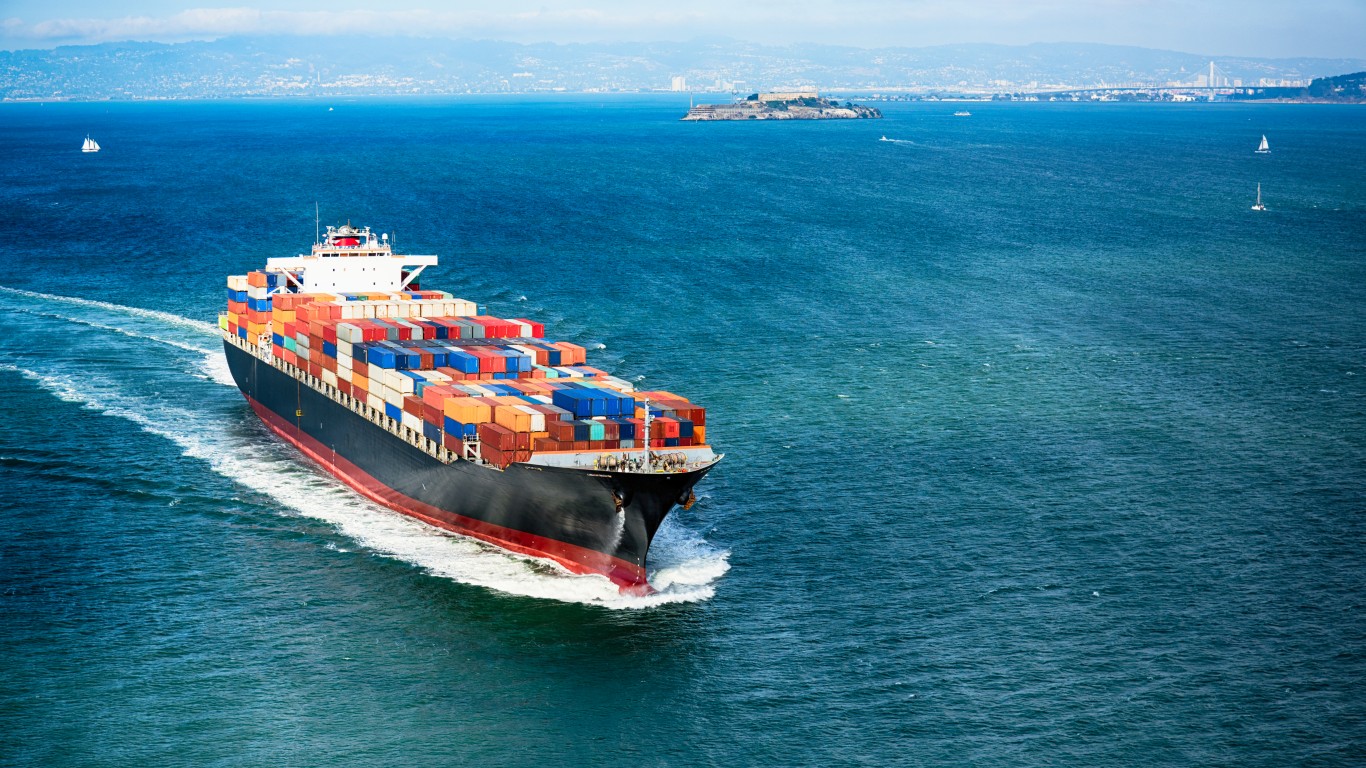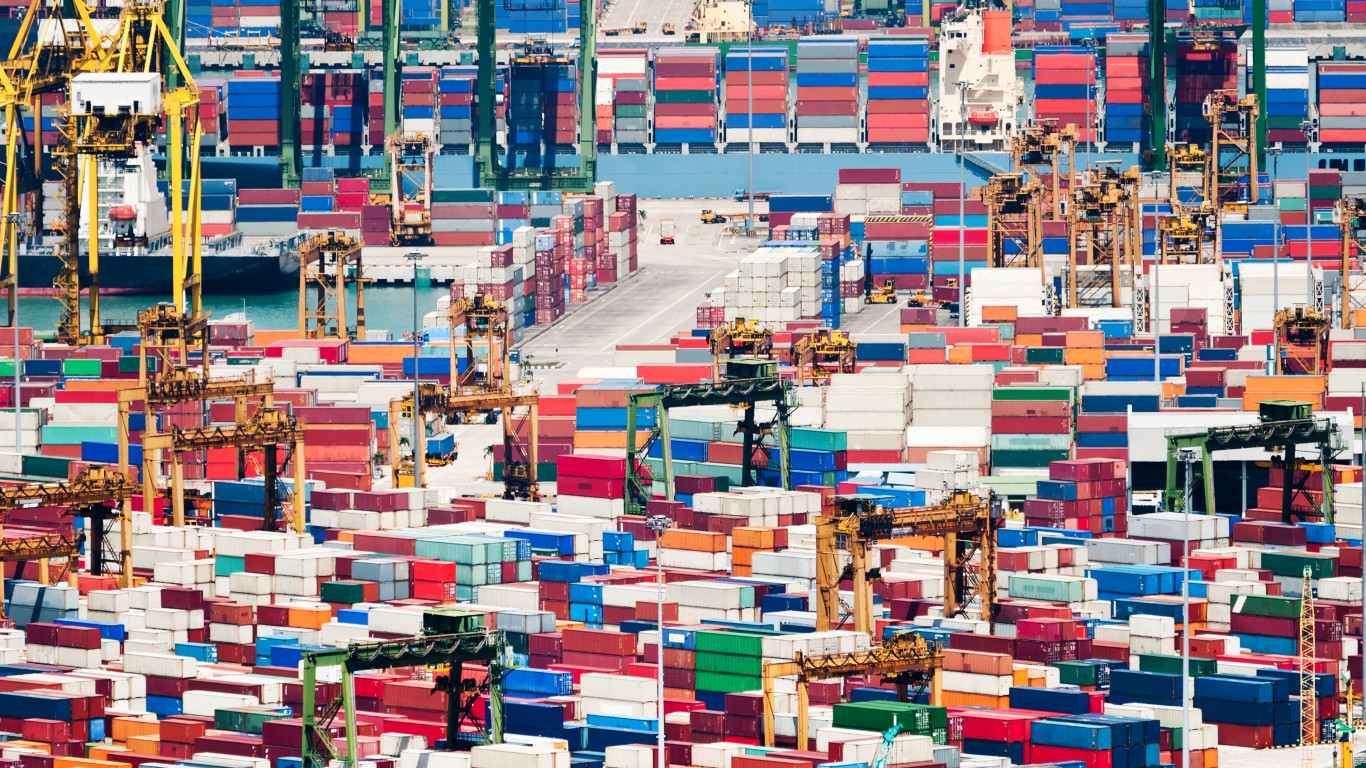
Global trade was hit hard in the early days of the COVID-19 pandemic, wreaking mayhem on supply chains. While international trade has returned to pre-pandemic levels, pent-up demand for goods and services and continued supply chain disruptions contributed to the global spike in prices. Prices are up in American grocery store staples as well as in developing, poorer countries.
Many of the nations whose economies have struggled most during the pandemic are heavily dependent on international trade. Some are low-income countries like Somalia, while others may be geographically small but have among the highest global per-capita incomes, like Luxembourg. (Find out if Luxembourg is among the countries where people have the highest average net incomes.)
To find the most trade-dependent economies in the world, 24/7 Wall St. ranked countries by imports as percent of gross domestic product, using data from the World Bank. Trade-dependent countries would rely on imports to satisfy their citizens’ needs. Additional data includes imports, exports, and trade as percent of GDP and in current U.S. dollars. GDP is also in current U.S. dollars. All data is from the World Bank for the most recent year available.
Exports and imports of goods and services include merchandise, freight services, communications services, banking, insurance, royalties, licensing fees and other valuables. They do not include so-called factor services, like the cost of employee compensation, investment income, or international money transfers.
Smaller countries lacking in natural and human resources tend to be more reliant on trade due to limitations of their size. Larger countries may be dependent on trade due to their stage of economic development and their struggles in developing industrialization and diversifying and growing their economies enough. Being reliant on trade makes these economies more vulnerable to global trade downturns. (These are the countries with the worst wealth inequality.)
Click here to see the most import-dependent economies in the world

25. Curacao
> Imports as % of GDP, 2016: 74.08%
> Imports in current US$, 2016: $2.31 billion – #33 lowest of 189 countries
> Trade as % of GDP, 2016: 131.43% – #27 largest of 190 countries
> Exports as % of GDP, 2016: 57.35% – #37 largest of 190 countries
> Exports in current US$, 2016: $1.79 billion – #40 lowest of 189 countries
> GDP in current US$, 2020: $2.60 billion – #25 lowest of 190 countries
The Dutch Caribbean island is known as the “Jewel of the Antilles” and as the name implies it relies heavily on drawing tourists to its pristine beaches and clear waters. In addition to offering offshore banking services, Curacao has a state-owned oil refinery and terminal that has struggled since the collapse of nearby Venezuela’s economy, but it’s been developing itself as a logistical trade hub.
[in-text-ad]

24. Aruba
> Imports as % of GDP, 2018: 74.63%
> Imports in current US$, 2018: $2.39 billion – #36 lowest of 189 countries
> Trade as % of GDP, 2018: 148.43% – #20 largest of 190 countries
> Exports as % of GDP, 2018: 73.80% – #18 largest of 190 countries
> Exports in current US$, 2018: $2.36 billion – #47 lowest of 189 countries
> GDP in current US$, 2018: $3.20 billion – #29 lowest of 190 countries
Like other Caribbean countries and territories, Aruba is heavily dependent on tourism and subsequently has been battered economically by the COVID-19 pandemic. Aruba, located close to Venezuela and Curacao, also offers offshore banking services and has transshipment and ship maintenance facilities.

23. Mozambique
> Imports as % of GDP, 2019: 75.08%
> Imports in current US$, 2019: $11.55 billion – #94 lowest of 189 countries
> Trade as % of GDP, 2019: 115.84% – #37 largest of 190 countries
> Exports as % of GDP, 2019: 40.76% – #65 largest of 190 countries
> Exports in current US$, 2019: $6.27 billion – #78 lowest of 189 countries
> GDP in current US$, 2020: $14.02 billion – #64 lowest of 190 countries
In 2011, gas fields were discovered off the coast of this largely impoverished southeastern African country, opening the way for economic transformation that has been hampered by an ongoing Islamist insurgency in the north. Mozambique’s top imports are refined petroleum and machinery. Its top exports include aluminum and coal.

22. Hungary
> Imports as % of GDP, 2020: 77.78%
> Imports in current US$, 2020: $121.19 billion – #35 largest of 189 countries
> Trade as % of GDP, 2020: 157.26% – #15 largest of 190 countries
> Exports as % of GDP, 2020: 79.48% – #12 largest of 190 countries
> Exports in current US$, 2020: $123.84 billion – #35 largest of 189 countries
> GDP in current US$, 2020: $155.81 billion – #54 largest of 190 countries
Hungary maintains a close trading relationship with Europe’s economic powerhouse, Germany. The country’s top imports include machinery, auto parts, and integrated circuits. The country’s top exports include machinery, auto parts, and pharmaceuticals. Its GDP expanded by 6.5%-7% last year.
[in-text-ad-2]

21. Dominica
> Imports as % of GDP, 2018: 78.35%
> Imports in current US$, 2018: $0.43 billion – #11 lowest of 189 countries
> Trade as % of GDP, 2018: 107.77% – #42 largest of 190 countries
> Exports as % of GDP, 2018: 29.41% – #88 lowest of 190 countries
> Exports in current US$, 2018: $0.16 billion – #11 lowest of 189 countries
> GDP in current US$, 2020: $0.50 billion – #6 lowest of 190 countries
Compared to other Caribbean countries and territories, Dominica’s tourism industry is relatively small, owing in part to an airport that’s too small to handle commercial jets and a dearth of white-sand beaches upon which to plant giant all-inclusive resorts. The tiny Caribbean island country has a population of only about 72,000 people, who depend on imports of fuel from other countries.

20. Cyprus
> Imports as % of GDP, 2020: 78.56%
> Imports in current US$, 2020: $19.34 billion – #80 largest of 189 countries
> Trade as % of GDP, 2020: 154.58% – #17 largest of 190 countries
> Exports as % of GDP, 2020: 76.03% – #16 largest of 190 countries
> Exports in current US$, 2020: $18.71 billion – #81 largest of 189 countries
> GDP in current US$, 2020: $24.61 billion – #85 lowest of 190 countries
The top industries for one of the European Union’s smallest member states include tourism, food and beverage processing, cement and gypsum production, and ship maintenance. Cyprus and Israel have been mired in a years-long dispute over gas drilling rights in the Mediterranean Sea. The island depends on fuel imports among others.
[in-text-ad]

19. Belgium
> Imports as % of GDP, 2020: 78.61%
> Imports in current US$, 2020: $410.22 billion – #15 largest of 189 countries
> Trade as % of GDP, 2020: 158.62% – #14 largest of 190 countries
> Exports as % of GDP, 2020: 80.01% – #11 largest of 190 countries
> Exports in current US$, 2020: $417.56 billion – #17 largest of 189 countries
> GDP in current US$, 2020: $521.86 billion – #23 largest of 190 countries
Benefitting from its proximity to Germany, EU’s largest economy, Belgium is known for its production of engineering products, scientific instruments, transportation equipment, and auto parts. Most of Belgium’s trade is with other EU member states but it also has a sizable trade relationship with Russia that could be adversely impacted by tensions between Moscow and Ukraine and its allies.
18. Nauru
> Imports as % of GDP, 2019: 78.92%
> Imports in current US$, 2019: $0.09 billion – #2 lowest of 189 countries
> Trade as % of GDP, 2019: 98.80% – #54 largest of 190 countries
> Exports as % of GDP, 2019: 19.88% – #46 lowest of 190 countries
> Exports in current US$, 2019: $0.02 billion – #2 lowest of 189 countries
> GDP in current US$, 2020: $0.11 billion – #1 lowest of 190 countries
This struggling Oceania microstate with a population of only about 11,000 residents has traditionally relied economically on phosphate mining. However, after that industry was depleted in recent years, Nauru has pivoted its dependence to the sale of fishing rights, offshoring business activities, and Australian financial support, in part for maintaining a controversial immigration detention and processing center. Nauru’s top import is refined petroleum.

17. Slovak Republic
> Imports as % of GDP, 2020: 84.51%
> Imports in current US$, 2020: $88.88 billion – #42 largest of 189 countries
> Trade as % of GDP, 2020: 169.95% – #11 largest of 190 countries
> Exports as % of GDP, 2020: 85.44% – #10 largest of 190 countries
> Exports in current US$, 2020: $89.86 billion – #42 largest of 189 countries
> GDP in current US$, 2020: $105.17 billion – #62 largest of 190 countries
Slovakia’s top exports include automobiles and auto parts and video and broadcasting equipment, while leading imports include automobiles and auto parts and crude oil and gas. Its top export or import markets are Germany, the Czech Republic, Poland, Hungary, France and Russia.
[in-text-ad-2]

16. Kiribati
> Imports as % of GDP, 2018: 87.25%
> Imports in current US$, 2018: $0.17 billion – #4 lowest of 189 countries
> Trade as % of GDP, 2018: 96.71% – #57 largest of 190 countries
> Exports as % of GDP, 2018: 9.47% – #12 lowest of 190 countries
> Exports in current US$, 2018: $0.02 billion – #1 lowest of 189 countries
> GDP in current US$, 2020: $0.20 billion – #2 lowest of 190 countries
This independent island nation in Oceania with a population of about 120,000 used to rely heavily on phosphate mining and export. After that resource was largely depleted, the small republic shifted relance to exporting coconut oil and fish, while its primary imports are refined petroleum, oil, rice, vehicles, and machinery.

15. American Samoa
> Imports as % of GDP, 2020: 91.82%
> Imports in current US$, 2020: $0.65 billion – #13 lowest of 189 countries
> Trade as % of GDP, 2020: 151.90% – #19 largest of 190 countries
> Exports as % of GDP, 2020: 60.08% – #32 largest of 190 countries
> Exports in current US$, 2020: $0.43 billion – #18 lowest of 189 countries
> GDP in current US$, 2020: $0.71 billion – #7 lowest of 190 countries
This South Pacific unincorporated territory of the United States, with a population of about 55,000, has a small trading profile. In 2019, its exports (led by fish oil, scrap iron, and auto parts) were valued at only $26.3 million, while its imports (led by refined petroleum, processed fish products, and vehicles) were worth $176 million.
[in-text-ad]

14. Timor-Leste
> Imports as % of GDP, 2020: 94.22%
> Imports in current US$, 2020: $1.79 billion – #29 lowest of 189 countries
> Trade as % of GDP, 2020: 162.96% – #13 largest of 190 countries
> Exports as % of GDP, 2020: 68.74% – #22 largest of 190 countries
> Exports in current US$, 2020: $1.31 billion – #32 lowest of 189 countries
> GDP in current US$, 2020: $1.90 billion – #22 lowest of 190 countries
The Southeast Asian island country, which became the first sovereign state of the 21st century in 2002, has been tapping its natural resources, led by oil and gas, as a source of export revenue. It maintains close trade ties with China, South Korea, Singapore, India, Japan, and its former parent country, Indonesia, from which it imports goods needed to build infrastructure. The country’s top import is refined petroleum.

13. Seychelles
> Imports as % of GDP, 2020: 100.48%
> Imports in current US$, 2020: $1.06 billion – #21 lowest of 189 countries
> Trade as % of GDP, 2020: 175.10% – #9 largest of 190 countries
> Exports as % of GDP, 2020: 74.62% – #17 largest of 190 countries
> Exports in current US$, 2020: $0.79 billion – #24 lowest of 189 countries
> GDP in current US$, 2020: $1.06 billion – #10 lowest of 190 countries
The archipelagic country with a population of about 98,000 recently hosted a massive U.S. military training operation by naval forces in the Indian Ocean, a sign of Seychelles’ strategic location. Its top exports include refined petroleum, processed seafood, and recreational boats, similar to its leading imports. Its leading export markets are the United Arab Emirates, the United Kingdom, France and Italy. The country’s imports are equal to its GDP.

12. Virgin Islands (U.S.)
> Imports as % of GDP, 2019: 101.08%
> Imports in current US$, 2019: $4.11 billion – #51 lowest of 189 countries
> Trade as % of GDP, 2019: 155.24% – #16 largest of 190 countries
> Exports as % of GDP, 2019: 54.15% – #43 largest of 190 countries
> Exports in current US$, 2019: $2.20 billion – #45 lowest of 189 countries
> GDP in current US$, 2019: $4.07 billion – #34 lowest of 190 countries
Like other Caribbean countries and territories, the economy of the U.S. Virgin Islands (with a population of about 106,000) relies heavily on tourism and has relatively small export/import activity, though its imports are greater than its GDP. Top exports, which comprise 54% of GDP, include light petroleum distillates, engine parts, motorboats, and jewelry. Top imports include petroleum products.
[in-text-ad-2]

11. Vietnam
> Imports as % of GDP, 2020: 102.70%
> Imports in current US$, 2020: $278.49 billion – #22 largest of 189 countries
> Trade as % of GDP, 2020: 208.25% – #8 largest of 190 countries
> Exports as % of GDP, 2020: 105.55% – #8 largest of 190 countries
> Exports in current US$, 2020: $286.21 billion – #23 largest of 189 countries
> GDP in current US$, 2020: $271.16 billion – #41 largest of 190 countries
In an effort to reduce its heavy dependence on trade with China, Vietnam has in recent years aggressively pursued free trade agreements with the European Union and other countries in Asia. Vietnam has also become an alternative to China as a manufacturing base, notably in textiles, footwear, and electronics. While the country imports over 100% of its GDP, it exports about the same amount.

10. Sint Maarten (Dutch part)
> Imports as % of GDP, 2018: 104.24%
> Imports in current US$, 2018: $1.24 billion – #23 lowest of 189 countries
> Trade as % of GDP, 2018: 171.72% – #10 largest of 190 countries
> Exports as % of GDP, 2018: 67.48% – #23 largest of 190 countries
> Exports in current US$, 2018: $0.80 billion – #25 lowest of 189 countries
> GDP in current US$, 2018: $1.19 billion – #12 lowest of 190 countries
The Dutch constituent country in the Caribbean (which shares an island with the French side) has been hit hard in recent years by two hurricanes and the coronavirus pandemic that shut down its tourism sector. It relies heavily on financial support from The Netherlands and imports over 100% of its GDP, while it exports a much smaller 67%.
[in-text-ad]

9. Lesotho
> Imports as % of GDP, 2020: 105.38%
> Imports in current US$, 2020: $1.98 billion – #31 lowest of 189 countries
> Trade as % of GDP, 2020: 152.51% – #18 largest of 190 countries
> Exports as % of GDP, 2020: 47.14% – #53 largest of 190 countries
> Exports in current US$, 2020: $0.88 billion – #27 lowest of 189 countries
> GDP in current US$, 2020: $1.88 billion – #21 lowest of 190 countries
The small mountainous landlocked country surrounded by South Africa has been adversely affected by slow global economic growth in recent years. The country imports about 105% worth of its GDP and more than twice the value of its exports, which include apparel. Main imports include refined petroleum and pharmaceutical products.

8. Somalia
> Imports as % of GDP, 2020: 107.62%
> Imports in current US$, 2020: $5.37 billion – #62 lowest of 189 countries
> Trade as % of GDP, 2020: 124.17% – #29 largest of 190 countries
> Exports as % of GDP, 2020: 16.55% – #29 lowest of 190 countries
> Exports in current US$, 2020: $0.83 billion – #26 lowest of 189 countries
> GDP in current US$, 2020: $4.99 billion – #38 lowest of 190 countries
This country on the Horn of Africa is on a fragile path of recovery from decades of internal conflict that have made its economy heavily reliant on imports coming mostly from the United Arab Emirates, China, India, and Turkey. Its primary exports, which comprise about 16% of GDP, include gold and livestock.

7. Ireland
> Imports as % of GDP, 2020: 108.84%
> Imports in current US$, 2020: $463.53 billion – #14 largest of 189 countries
> Trade as % of GDP, 2020: 239.95% – #7 largest of 190 countries
> Exports as % of GDP, 2020: 131.11% – #7 largest of 190 countries
> Exports in current US$, 2020: $558.39 billion – #11 largest of 189 countries
> GDP in current US$, 2020: $425.89 billion – #27 largest of 190 countries
The largest EU member state on this list is also one of the most economically dynamic on this list. The latest World Bank data shows Ireland’s exports are worth $558 billion, while its imports are valued at $463 billion, or about 109% of GDP. Top exports include vaccines and pharmaceutical products, while leading imports include aircraft and computers.
[in-text-ad-2]

6. Malta
> Imports as % of GDP, 2020: 130.97%
> Imports in current US$, 2020: $19.18 billion – #81 largest of 189 countries
> Trade as % of GDP, 2020: 271.55% – #6 largest of 190 countries
> Exports as % of GDP, 2020: 140.58% – #6 largest of 190 countries
> Exports in current US$, 2020: $20.59 billion – #77 largest of 189 countries
> GDP in current US$, 2020: $14.65 billion – #66 lowest of 190 countries
This tiny island country and EU member state relies heavily on the maritime industry, including shipping, storage, and bunkering. The country’s primary exports include oil and mineral fuels and pharmaceuticals, and top imports include seacraft and electrical machinery.

5. Djibouti
> Imports as % of GDP, 2020: 140.33%
> Imports in current US$, 2020: $4.75 billion – #57 lowest of 189 countries
> Trade as % of GDP, 2020: 293.78% – #5 largest of 190 countries
> Exports as % of GDP, 2020: 153.44% – #5 largest of 190 countries
> Exports in current US$, 2020: $5.19 billion – #69 lowest of 189 countries
> GDP in current US$, 2020: $3.38 billion – #30 lowest of 190 countries
Ismaïl Omar Guelleh won a fifth term as president of Djibouti last year, reportedly thanks to a positive economic record. The small impoverished East African republic has a population of about 990,000. The country’s imports were valued at 140% of GDP, though exports were even higher.
[in-text-ad]

4. San Marino
> Imports as % of GDP, 2019: 143.27%
> Imports in current US$, 2019: $2.32 billion – #34 lowest of 189 countries
> Trade as % of GDP, 2019: 307.26% – #4 largest of 190 countries
> Exports as % of GDP, 2019: 164.00% – #4 largest of 190 countries
> Exports in current US$, 2019: $2.65 billion – #52 lowest of 189 countries
> GDP in current US$, 2019: $1.62 billion – #17 lowest of 190 countries
This European microstate landlocked inside Italy has only about 34,000 residents living in 38 square miles whose standard of living is comparable with Italy’s wealthiest. The economy is largely services based, focusing on tourism and banking. The country imports 143% of its GDP, with top imports including electricity, cars, and aluminum, but also exports 164% of GDP. Top export include washing and bottling machines and medications.

3. Singapore
> Imports as % of GDP, 2020: 144.32%
> Imports in current US$, 2020: $490.69 billion – #12 largest of 189 countries
> Trade as % of GDP, 2020: 320.56% – #3 largest of 190 countries
> Exports as % of GDP, 2020: 176.24% – #3 largest of 190 countries
> Exports in current US$, 2020: $599.22 billion – #9 largest of 189 countries
> GDP in current US$, 2020: $340.00 billion – #36 largest of 190 countries
The Southeast Asian city-state of about 5.7 million people was ranked by the conservative Heritage Foundation as the world’s most open, pro-business economy in 2021. The World Bank reports that Singapore’s top exports are led by integrated circuits, petroleum oils, and semi-manufactured gold, making foreign trade the source of most of Singapore’s revenue. The country depends heavily on imports too, with imports worth about 144% of GDP.

2. Luxembourg
> Imports as % of GDP, 2020: 171.60%
> Imports in current US$, 2020: $125.88 billion – #34 largest of 189 countries
> Trade as % of GDP, 2020: 376.30% – the largest of 190 countries
> Exports as % of GDP, 2020: 204.69% – the largest of 190 countries
> Exports in current US$, 2020: $150.15 billion – #34 largest of 189 countries
> GDP in current US$, 2020: $73.35 billion – #70 largest of 190 countries
The primary products of this wealthy landlocked European country of about 632,000 people includes metals, machinery and electronics, and plastic or rubber. It also relies heavily on services, especially banking. According to the World Bank’s latest data, Luxembourg had a negative trade balance, with exports of $150 billion versus imports of $126 billion, or 170% of GDP.
[in-text-ad-2]

1. Hong Kong SAR, China
> Imports as % of GDP, 2020: 174.92%
> Imports in current US$, 2020: $606.25 billion – #8 largest of 189 countries
> Trade as % of GDP, 2020: 351.66% – #2 largest of 190 countries
> Exports as % of GDP, 2020: 176.74% – #2 largest of 190 countries
> Exports in current US$, 2020: $612.57 billion – #8 largest of 189 countries
> GDP in current US$, 2020: $346.59 billion – #35 largest of 190 countries
The special administrative region of China is the world’s most trade-dependent economy. Both of the country’s imports and exports were worth around 175% of its total GDP for a total trade value of 350% of GDP. This means that while the country has the 35th largest economy by GDP, it has the eighth largest imports and exports values, and the second highest total trade value.
The World Bank estimates that almost 70% of Hong Kong exports consisted of machinery and electronics, while its primary imports include machinery and transportation equipment, manufactured consumer goods, and food and live animals.
Travel Cards Are Getting Too Good To Ignore (sponsored)
Credit card companies are pulling out all the stops, with the issuers are offering insane travel rewards and perks.
We’re talking huge sign-up bonuses, points on every purchase, and benefits like lounge access, travel credits, and free hotel nights. For travelers, these rewards can add up to thousands of dollars in flights, upgrades, and luxury experiences every year.
It’s like getting paid to travel — and it’s available to qualified borrowers who know where to look.
We’ve rounded up some of the best travel credit cards on the market. Click here to see the list. Don’t miss these offers — they won’t be this good forever.
Thank you for reading! Have some feedback for us?
Contact the 24/7 Wall St. editorial team.
 24/7 Wall St.
24/7 Wall St.
 24/7 Wall St.
24/7 Wall St. 24/7 Wall St.
24/7 Wall St.


